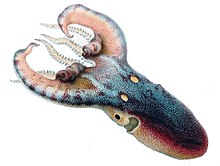| Common blanket octopus | |
|---|---|

| |

| |
| Scientific classification | |
| Domain: | Eukaryota |
| Kingdom: | Animalia |
| Phylum: | Mollusca |
| Class: | Cephalopoda |
| Order: | Octopoda |
| Family: | Tremoctopodidae |
| Genus: | Tremoctopus |
| Species: | T. violaceus
|
| Binomial name | |
| Tremoctopus violaceus Delle Chiaje, 1830
| |
 | |
| Range of Tremoctopus violaceus [2] | |
| Synonyms[3] | |
| |
The common blanket octopus or violet blanket octopus (Tremoctopus violaceus)[4] is a large octopus of the family Tremoctopodidae found worldwide in the epipelagic zone of warm seas. The degree of sexual dimorphism in this species is very high, with females growing up to two meters in length, whereas males grow to about 2.4 cm. The first live specimen of a male was not seen until 2002 off the Great Barrier Reef. Individual weights of males and females differ by a factor of about 10,000 and potentially more.[5]
Males and small females of less than 7 cm have been reported to carry with them the tentacles of the Portuguese man o' war. It is speculated that these tentacles serve both as a defensive mechanism and possibly as a method of capturing prey. This mechanism is no longer useful at larger sizes, which may be why males of this species are so small. The web between the arms of the mature female octopus serves as a defensive measure as well, making the animal appear larger, and being easily detached if bitten into by a predator.[6] The complete mitogenome of T. violaceus is a circular double-stranded DNA sequence that is 16,015 base-pairs long.[7]
-
Ventral view of large female
-
Dorsal view of large female
-
Dorsal view of female
-
Lateral view of adult male with hectocotylus
- ^ Allcock, L. (2014). "Tremoctopus violaceus". IUCN Red List of Threatened Species. 2014: e.T174487A1415800. doi:10.2305/IUCN.UK.2014-3.RLTS.T174487A1415800.en. Retrieved 20 November 2021.
- ^ Jiménez-Badillo, María de Lourdes; Meiners-Mandujano, César; Galindo-Cortes, Gabriela; Morillo-Velarde, Piedad S.; González-Gómez, Roberto; Barriga-Sosa, Irene de los Angeles; Pliego-Cárdenas, Ricardo (2021). "The first record of Tremoctopus violaceus sensu stricto Delle Chiaje, 1830 in southwestern Gulf of Mexico gives a hint of the taxonomic status of Tremoctopus gracilis". ZooKeys (1012): 55–69. doi:10.3897/zookeys.1012.55718. PMC 7854555. PMID 33584108.
- ^ Sweeney, M.J. & R.E. Young (2004). Taxa Associated with the Family Tremoctopodidae Tryon, 1879. Tree of Life Web Project.
- ^ "Common Blanket Octopus Tremoctopus violaceus". BioLib Biological Library. Retrieved 24 May 2022.
- ^ Norman, M. D.; Paul, D.; Finn, J.; Tregenza, T. (2002). "First encounter with a live male blanket octopus: The world's most sexually size‐dimorphic large animal". New Zealand Journal of Marine and Freshwater Research. 36 (4): 733–736. doi:10.1080/00288330.2002.9517126. ISSN 0028-8330.
- ^ Shapiro, Leo. "Facts about Common Blanket Octopus". Encyclopedia of Life. Retrieved 21 March 2012.
- ^ Yuh-Wen Chiu; Chih-Wei Chang; Kang-Ning Shen; Yu-Min Ju; Hung-Du Lin (2018). "Complete mitochondrial genome and the phylogenetic position of the pelagic octopus Tremoctopusviolaceus (Mollusca: Tremoctopodidae)". Mitochondrial DNA Part B. 3 (2): 1248–1249. doi:10.1080/23802359.2018.1532347. PMC 7799641. PMID 33474480.




